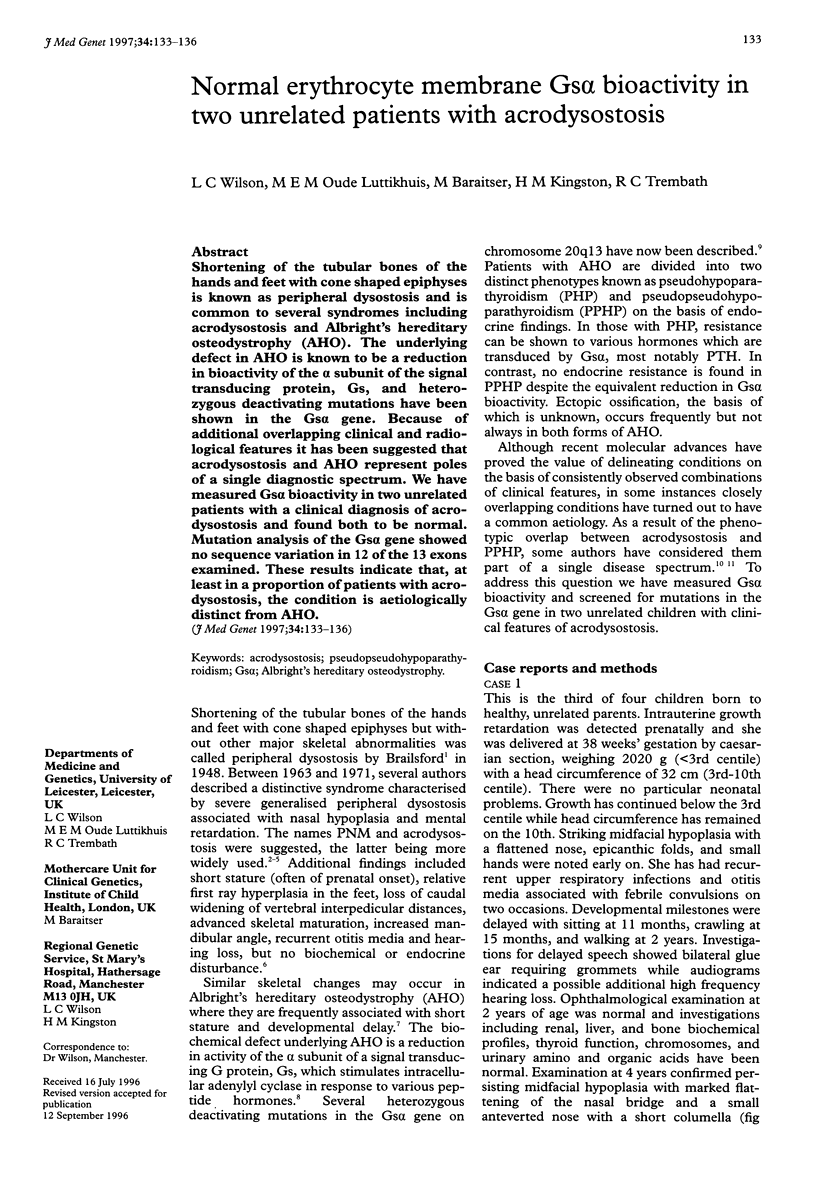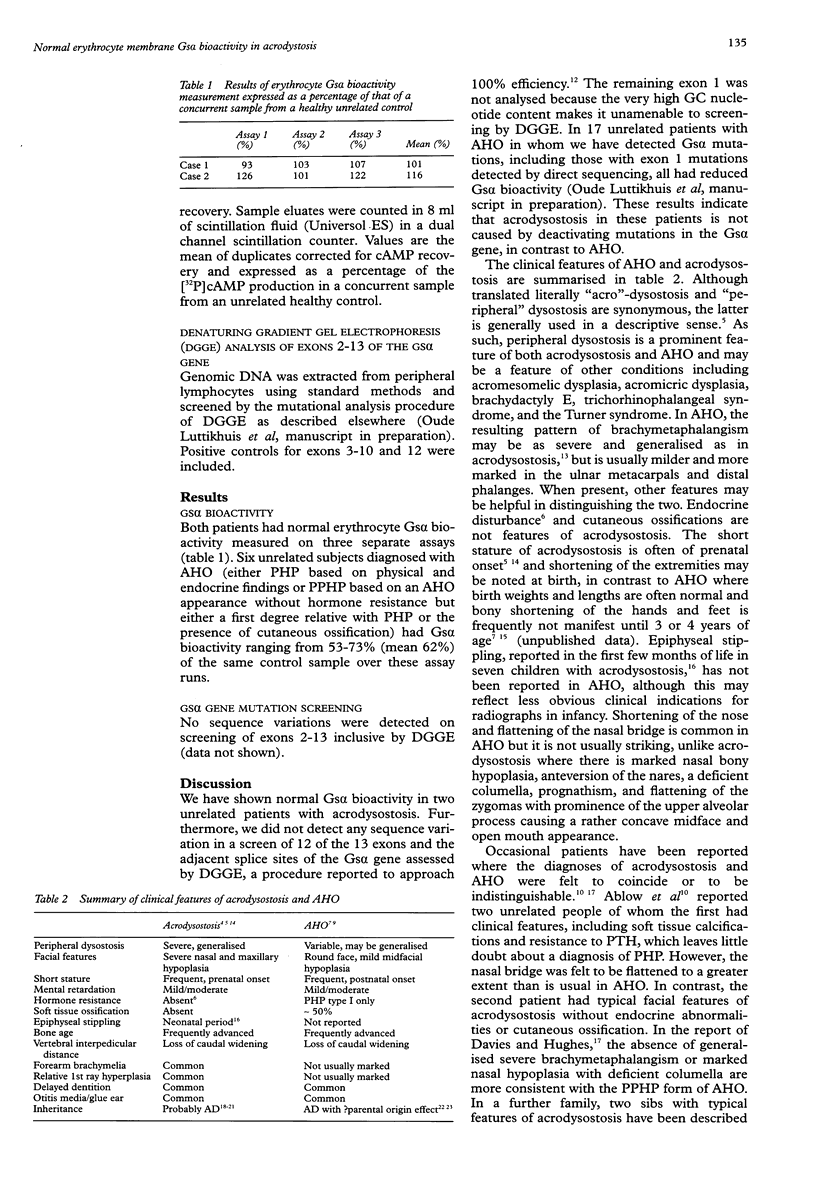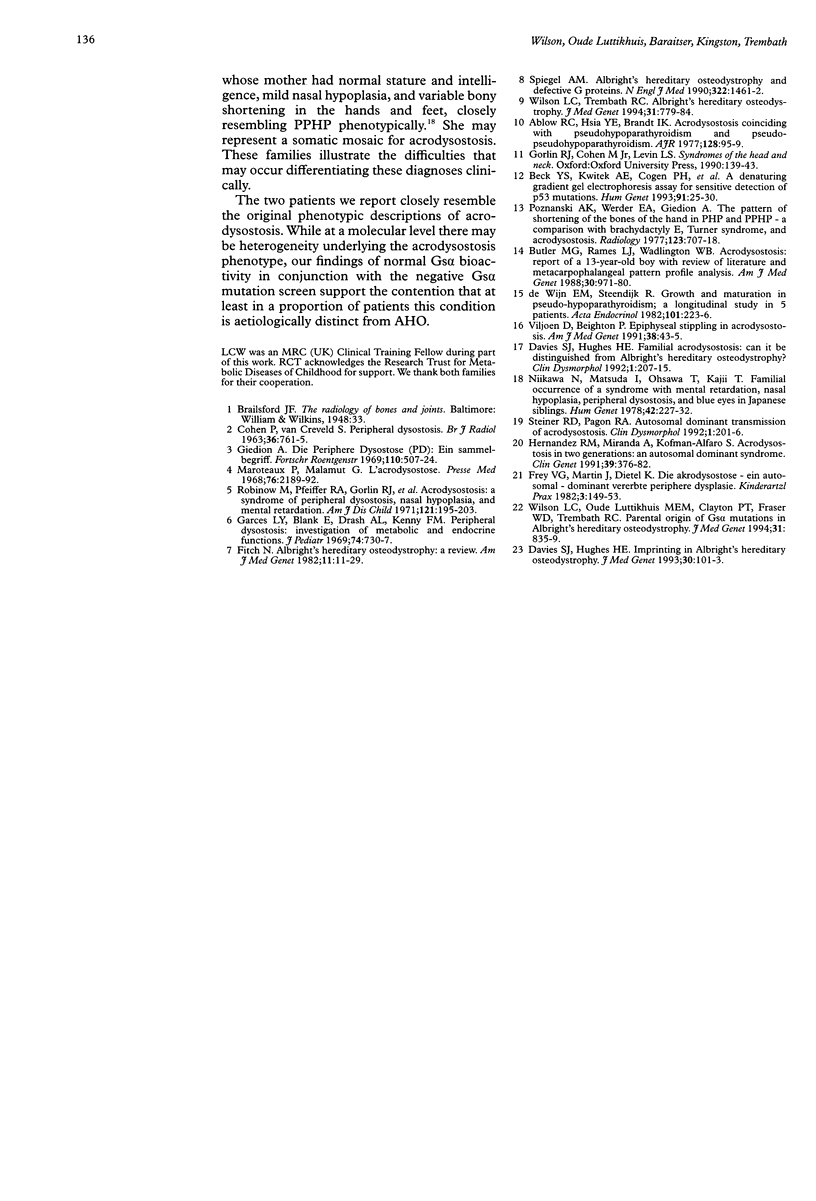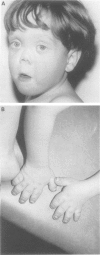Abstract
Shortening of the tubular bones of the hands and feet with cone shaped epiphyses is known as peripheral dysostosis and is common to several syndromes including acrodysostosis and Albright's hereditary osteodystrophy (AHO). The underlying defect in AHO is known to be a reduction in bioactivity of the alpha subunit of the signal transducing protein, Gs, and heterozygous deactivating mutations have been shown in the Gs alpha gene. Because of additional overlapping clinical and radiological features it has been suggested that acrodysostosis and AHO represent poles of a single diagnostic spectrum. We have measured Gs alpha bioactivity in two unrelated patients with a clinical diagnosis of acrodysostosis and found both to be normal. Mutation analysis of the Gs alpha gene showed no sequence variation in 12 of the 13 exons examined. These results indicate that, at least in a proportion of patients with acrodysostosis, the condition is aetiologically distinct from AHO.
Full text
PDF



Images in this article
Selected References
These references are in PubMed. This may not be the complete list of references from this article.
- Beck J. S., Kwitek A. E., Cogen P. H., Metzger A. K., Duyk G. M., Sheffield V. C. A denaturing gradient gel electrophoresis assay for sensitive detection of p53 mutations. Hum Genet. 1993 Mar;91(1):25–30. doi: 10.1007/BF00230217. [DOI] [PubMed] [Google Scholar]
- Butler M. G., Rames L. J., Wadlington W. B. Acrodysostosis: report of a 13-year-old boy with review of literature and metacarpophalangeal pattern profile analysis. Am J Med Genet. 1988 Aug;30(4):971–980. doi: 10.1002/ajmg.1320300416. [DOI] [PMC free article] [PubMed] [Google Scholar]
- COHEN P., VAN CREVELD PERIPHERAL DYSOSTOSIS. Br J Radiol. 1963 Oct;36:761–765. doi: 10.1259/0007-1285-36-430-761. [DOI] [PubMed] [Google Scholar]
- Davies S. J., Hughes H. E. Familial acrodysostosis: can it be distinguished from Albright's hereditary osteodystrophy? Clin Dysmorphol. 1992 Oct;1(4):207–215. [PubMed] [Google Scholar]
- Davies S. J., Hughes H. E. Imprinting in Albright's hereditary osteodystrophy. J Med Genet. 1993 Feb;30(2):101–103. doi: 10.1136/jmg.30.2.101. [DOI] [PMC free article] [PubMed] [Google Scholar]
- Fitch N. Albright's hereditary osteodystrophy: a review. Am J Med Genet. 1982 Jan;11(1):11–29. doi: 10.1002/ajmg.1320110104. [DOI] [PubMed] [Google Scholar]
- Frey G., Martin J., Dietel K. Die Akrodysostose--eine autosomal-dominant vererbte periphere Dysplasie. Kinderarztl Prax. 1982 Mar;50(3):149–153. [PubMed] [Google Scholar]
- Garces L. Y., Blank E., Drash A. L., Kenny F. M. Peripheral dysostosis: investigation of metabolic and endocrine functions. J Pediatr. 1969 May;74(5):730–737. doi: 10.1016/s0022-3476(69)80135-6. [DOI] [PubMed] [Google Scholar]
- Giedion A. Die periphere Dysostose (PD)--einSammelbegriff. Fortschr Geb Rontgenstr Nuklearmed. 1969 Apr;110(4):507–524. [PubMed] [Google Scholar]
- Hernández R. M., Miranda A., Kofman-Alfaro S. Acrodysostosis in two generations: an autosomal dominant syndrome. Clin Genet. 1991 May;39(5):376–382. doi: 10.1111/j.1399-0004.1991.tb03045.x. [DOI] [PubMed] [Google Scholar]
- Maroteaux P., Malamut G. L'acrodysostose. Presse Med. 1968 Nov 27;76(46):2189–2192. [PubMed] [Google Scholar]
- Niikawa N., Matsuda I., Ohsawa T., Kajii T. Familial occurrence of a syndrome with mental retardation, nasal hypoplasia, peripheral dysostosis, and blue eyes in Japanese siblings. Hum Genet. 1978 Jun 9;42(2):227–232. doi: 10.1007/BF00283643. [DOI] [PubMed] [Google Scholar]
- Poznanski A. K., Werder E. A., Giedion A., Martin A., Shaw H. The pattern of shortening of the bones of the hand in PHP and PPHP--A comparison with brachydactyly E, Turner Syndrome, and acrodysostosis. Radiology. 1977 Jun;123(3):707–718. doi: 10.1148/123.3.707. [DOI] [PubMed] [Google Scholar]
- Robinow M., Pfeiffer R. A., Gorlin R. J., McKusick V. A., Renuart A. W., Johnson G. F., Summitt R. L. Acrodysostosis. A syndrome of peripheral dysostosis, nasal hypoplasia, and mental retardation. Am J Dis Child. 1971 Mar;121(3):195–203. [PubMed] [Google Scholar]
- Spiegel A. M. Albright's hereditary osteodystrophy and defective G proteins. N Engl J Med. 1990 May 17;322(20):1461–1462. doi: 10.1056/NEJM199005173222010. [DOI] [PubMed] [Google Scholar]
- Steiner R. D., Pagon R. A. Autosomal dominant transmission of acrodysostosis. Clin Dysmorphol. 1992 Oct;1(4):201–206. [PubMed] [Google Scholar]
- Wilson L. C., Oude Luttikhuis M. E., Clayton P. T., Fraser W. D., Trembath R. C. Parental origin of Gs alpha gene mutations in Albright's hereditary osteodystrophy. J Med Genet. 1994 Nov;31(11):835–839. doi: 10.1136/jmg.31.11.835. [DOI] [PMC free article] [PubMed] [Google Scholar]
- Wilson L. C., Trembath R. C. Albright's hereditary osteodystrophy. J Med Genet. 1994 Oct;31(10):779–784. doi: 10.1136/jmg.31.10.779. [DOI] [PMC free article] [PubMed] [Google Scholar]
- de Wijn E. M., Steendijk R. Growth and maturation in pseudo-hypoparathyroidism: a longitudinal study in 5 patients. Acta Endocrinol (Copenh) 1982 Oct;101(2):223–226. doi: 10.1530/acta.0.1010223. [DOI] [PubMed] [Google Scholar]




